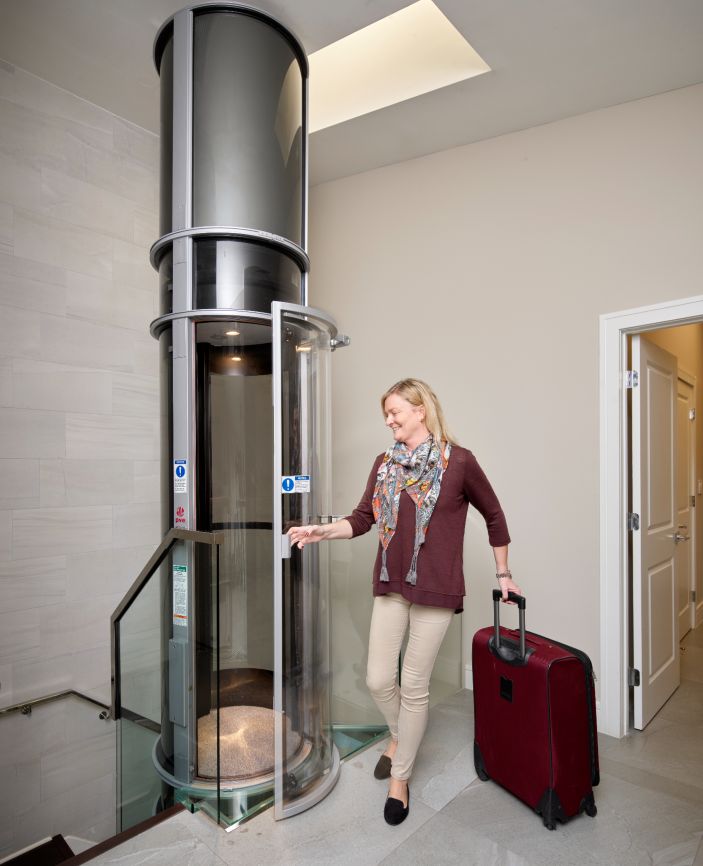Digging Into the World of Lifts: Common Concerns Dealt With by Numerous Lift Systems
As we browse with the upright transport systems of modern buildings, lifts stick out as a vital element of our lives. Nonetheless, behind their seamless procedure lies a world of detailed systems that can in some cases run into challenges. From hydraulic lifts to traction systems and machine-room-less styles, each lift kind comes with its set of usual issues. Comprehending these challenges is important for ensuring the smooth functioning of these important systems. Allow's check out the complexities that underlie the operation of lifts and the potential issues that can arise, clarifying the complex internet of lift mechanisms.
Hydraulic Lifts
Hydraulic lifts, often chosen for low-rise structures, utilize fluid pressure to manage the motion of the lift car (lift repair companies). This mechanism involves a hydraulic pump pushing oil right into a cyndrical tube, creating the lift to relocate the wanted instructions. While hydraulic lifts are known for their peaceful and smooth operation, they do include their own set of typical issues
One common issue with hydraulic elevators is oil leakage. Furthermore, issues with the control system, such as faulty shutoffs or a malfunctioning pump, can trigger interruptions in the elevator's activity.
Normal upkeep and timely repairs are important to guarantee the smooth performance of hydraulic lifts. By dealing with these common concerns proactively, building owners can decrease downtime and make sure the safety and performance of their vertical transportation system.
Grip Lifts
When considering upright transportation systems in structures, one more common kind besides hydraulic lifts is the traction elevator. Traction lifts operate using a system of ropes and weights that move the lift vehicle by clutching onto the hoist ropes. This system allows for smoother and faster upright transportation contrasted to hydraulic systems.
One of the usual issues encountered by traction elevators is rope wear. The consistent motion of the ropes within the grip system can result in tear and wear with time, possibly causing the lift to malfunction or become risky for use. Regular examinations and maintenance of the ropes are necessary to guarantee the lift's appropriate functioning and safety and security.
One more issue that grip elevators might experience is associated with the control system. Issues with the control system can cause issues such as unpredictable motion, hold-ups in response times, or even full closures. Routine testing and upkeep of the control system are important to protect against such issues and guarantee the elevator's dependability.
Machine-Room-Less (MRL) Lifts

One of the key elements of MRL elevators is the portable gearless traction machine that is set up within the hoistway. This machine successfully drives the elevator car without the requirement for bulky tools found in typical traction lifts. Additionally, MRL elevators commonly utilize a counterweight system to balance the car, additional boosting their energy performance.
Despite their benefits, MRL lifts might face difficulties associated with repair and maintenance because of the constrained area for devices installment. Access for servicing components within the shaft can be limited, needing specialized training for specialists. Appropriate upkeep schedules and routine examinations are crucial to guarantee the continued smooth operation of MRL elevators.
Overloading and Weight Limitation Issues
Straining and weight restriction problems are vital issues in lift procedures. Lift makers design raises with details weight capabilities to guarantee passenger safety and security and devices durability.
When elevators are strained, it puts excessive pressure on the motor, cables, and various other components, possibly triggering malfunctions or failures. If they identify excess weight, security mechanisms such as go to these guys sensors and overload sensing units are in location to protect against elevators from relocating. Furthermore, going beyond weight limitations can bring about boosted power usage and damage on the elevator system.
To minimize overloading concerns, building supervisors should prominently show weight limits in elevators and enlighten residents on the value of adhering to these limitations - lift repair companies. Normal upkeep checks by qualified specialists can also assist make sure that lifts are operating within risk-free weight criteria. By resolving overloading and weight limit problems proactively, structure proprietors can enhance elevator security and performance
Electrical System Failures
Surpassing weight restrictions in lifts can not only result in mechanical problems yet additionally possibly contribute to electrical system failures within the lift facilities. Electric system failings are a critical concern in lift operation, as they can cause unforeseen shutdowns, malfunctions, or also safety and security threats. One usual electric concern is the getting too hot of components due to excessive current flow brought on by overwhelming the lift beyond its capacity. This can result in damage to the motor, control, or wiring web systems, causing pricey fixings and downtime.
Furthermore, power surges or variations in the electric supply can also disrupt the lift's operation, influencing its efficiency and security. These electric disruptions can damage delicate elevator components such as control board, circuit boards, or sensors, bring about system failings. Regular upkeep and assessments are important to identify and address potential electrical concerns quickly, ensuring the secure and efficient procedure of elevator systems. By sticking to weight limits and performing routine electric system checks, building proprietors can mitigate the threat of electrical failings in elevators.
Conclusion

Hydraulic elevators, usually liked for low-rise structures, use fluid stress to manage the activity of the elevator auto.When thinking about upright transport systems in buildings, one more usual type apart from hydraulic elevators is the traction lift. Grip address elevators operate making use of a system of ropes and counterweights that move the lift vehicle by clutching onto the hoist ropes. Unlike traditional elevators that call for a different device area to house the equipment, MRL elevators integrate many of the parts within the shaft, eliminating the requirement for a dedicated device room.In final thought, lifts encounter common problems such as hydraulic breakdowns, grip system failings, and electric system problems.